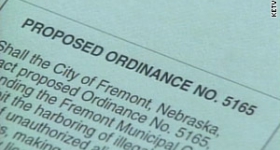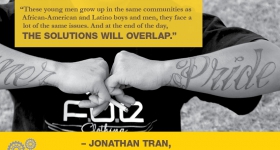M.I.A. at the Super Bowl, photo courtesy of thegrio.com.
By
now pretty much everyone knows M.I.A. as the bad girl who flipped off
the Super Bowl halftime camera. But her fans are more preoccupied with her new
music video, “Bad Girls”,
in which BMWs and Mercedes Benzes race in a desert we presume to be in the
Middle East, tires burn in nameless oil states, Bedouin-styled men ride
stallions à la Casablanca, brown rebel-types
tote guns, and backup dancers appear in not-quite-accurate hipsterized niqab and hijab.
I’ve
watched the video dozens of times. I love the scenes of Oakland-style “ghost
ridin’
the
whip,”
and I keep rewinding to the highway stuntmen skidding while gripping the doors
of the speeding car at 2’55”. Yet I’m still left wondering how to make sense of
“Bad Girls.”
I’ve
always been drawn to the art of M.I.A. -- a Sri Lankan Tamil raised in England.
When I first saw her “Galang” video back in 2005, I
was awestruck: to have a visible Sri Lankan in Western popular culture seemed
implausible. What struck me about M.I.A. early on is that she often positioned
herself in relation to the Global South -- in videos emphasizing dance (i.e., “Bird Flu,” filmed in South
India near Sri Lankan Tamil refugee camps; “Bucky Done Gun” in
Brazil; and “Boyz”
in Jamaica) or highlighting
immigrant enclaves in the West (think “Paper Planes” in
Brooklyn). The new video is much less clear in intent.
On
Facebook and Twitter, there’s hot debate over “Bad Girls.” Many absolutely love
the video, proclaiming it to be M.I.A’s big comeback, while others remain unsure.
Some see it as embodying resistance to the norm, while others don’t think it
resists enough.
For
my part, I’m taken in but left feeling uneasy. What’s missing is the present
context of North Africa and the Middle East; it’s been a year since the revolution that toppled Tunisia’s Ben Ali, Egypt’s
#Jan25
call that led to the ousting of
Hosni Mubarak, the Libyan uprising against
Muammar Qaddafi, and ongoing struggles for political justice in Syria
and Yemen.
Images, videos, and news reports of the region have shown inspiring scenes of
resistance.

Egyptian women
protest military rule. Photo courtesy of Al Jazeera.
But
in “Bad Girls”’ depictions of the Arab world, I see a false, hyped-up
misrepresentation of the region we now know for the Arab Spring. I’m bothered
by M.I.A.’s reproduction of Orientalist tropes -- “Orientalist” in Edward
Said’s sense, of a distorted lens through which Arabs are viewed and
“experienced” by the West. “Bad Girls” is just a hipper, high-definition
stereotype of Arabs as desert-dwelling, sword-wielding, horse-riding, and
dangerous.
M.I.A.
and the video’s director, Romain Gavrais, perform controversy for the sake of
controversy and cash in on the Arab Spring. They aestheticize the recent
uprisings while avoiding a precise political statement.
I
get that it’s just a music video. I also get that there’s only so much a music
video can do. At the same time, compared to a reality in which Arab peoples are
demanding control of their own representation, not as terrorists or blank faces
with guns but as people fighting for political voice, “Bad Girls” seems lacking
in creativity and vision. While undeniably hip, M.I.A.’s video is politically
vacant in comparison to lesser-known artists with far fewer resources -- like DAM and Shadia Mansoor
from Palestine and the Iraqi-Canadian rapper The Narcicyst.
Some
have suggested that “Bad Girls” is a commentary
on Saudi Arabia’s ban on women drivers. But this connection seems forced, borne
of a desire to make sense of the video and give it a political meaning it does
not in fact have. If such commentary were the point, it’d be women who drive
the sideways-careening car upon which M.I.A. casually files her nails. And
perhaps there’d be more women in the video altogether -- and I mean representative Arab women, not dancers
dressed in hipster hijabi get-ups.

Manal Al-Sharif drives. Photo courtesy of Newsone.com.
M.I.A.
has nothing on the real bad girls:
Saudi women who have defied the ban on women driving -- like Wajeha al-Hawedar
or Manal
Al
Sherif,
who just filed
suit
over the ban last week -- or the Egyptian women who played a critical role in
the marches and demonstrations against Mubarak.
In
fact, M.I.A.’s Orientalism-meets-resistance is nothing new. Last year, on a
world tour, her contract and casting call specified that the onstage extras would wear full burkas. And for what purpose -- to bring
attention to the stereotypical submission of women who wear the veil or to
objectify them ironically? Just because M.I.A. is “brown” doesn’t mean she gets
to objectify non-Western cultures. Against the reality of North Africa and the
Middle East today, the thrill of high-speed desert racing only gets her so far.
Thanu Yakupitiyage was born in Sri Lanka, raised
in Thailand, and came to the U.S. to attend college. She now lives
in New York City, where she is an immigrant rights activist and media
expert by trade. She also organizes in communities of color through OWS and dabbles in music and pop culture. You can follow her on twitter at @ty_ushka.









Comments
Thanu, great post. I'm a huge fan of M.I.A. as well. I love her music, think she's done amazing things, and I really like this song, too. Yet I remain disturbed by how thoughtless and objectifying the video is. And you're completely right, just because M.I.A.'s brown doesn't mean she gets a pass on this.
Thanks for the analysis, for breaking this all down.